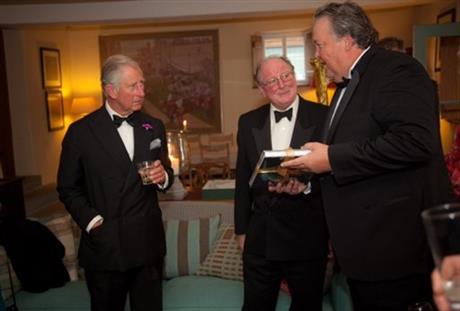
By RAMIT PLUSHNICK-MASTI
In this courtesy photo provided by the Hereford Cathedral Perpetual Trust, from left, England’s Prince Charles, Christopher James, Chairman of Hereford Perpetual Trust, and Joel A. Bartsch, President of the Houston Museum of Natural Science gather for a black-tie dinner at Prince Charles’ country estate in Wales, Llwynywermod, where a partnership was discussed to bring one of the four 1217 Magna Cartas to the Houston Museum of Natural Science for viewing. The British archive that holds the document says the trip might be the first time it has left Hereford, England, since it was issued. (AP Photo/Huw Evans Picture Agency, Gareth Everett)
HOUSTON (AP) — Nearly 800 years after the king of England tried to avert a civil war by issuing the Magna Carta, a rarely seen version of the document is coming to the United States, which enshrined many of the charter’s freedoms in the Bill of Rights and the Constitution.
The trip to the Houston Museum of Natural Science is believed to be the first time the delicate, yellowed parchment has left England since it was issued in 1217, two years after the first version of the Magna Carta was distributed. Also on exhibit will be a related legal notice, or writ, issued by the king.
“These are truly rare and ancient documents. They are national treasures that have been guarded for centuries and don’t typically leave England’s shores,” said Catherine F. Patterson, a British historian at the University of Houston.
The Magna Carta, one of only a few surviving copies, has been publicly displayed only about a dozen times and the writ barely half that number of times, said Glyn Morgan, chief executive of the Hereford Cathedral Perpetual Trust, which holds the medieval documents in its archives.
Originally issued by King John in Runnymeade on June 15, 1215, the Magna Carta granted his barons certain freedoms, including three that live on today: an acknowledgement that taxes cannot be arbitrary, that free men cannot be imprisoned without first being judged by their peers or the law and that justice cannot be denied or delayed.
“In a very primitive, or a very early way, they do set a notion that power should not be arbitrary and that the king in this case functions under the law,” Patterson explained. “And that was important in its own time.”
The document “represents a living, breathing legacy of law that extends from 800 years ago until today, from a few rich barons and a king on a rural field in medieval England to a modern, dynamic, diverse metropolis in Houston, Texas,” she added in an email.
While scribes were handwriting the Magna Carta in Latin, the king sent sheriffs and constables advance notice — or a writ — telling them to expect new royal orders, Morgan said.
At the time, there were probably dozens of copies of the writ, but the only known surviving one is owned by the trust. It was addressed to the sheriff of Gloucester.
“It was a note that just said, ‘Get yourself ready. You’re going to be told to get and do something,'” Morgan said. “If you received an email like that now, you’d probably delete it straight away. It potentially had the same affect.”
Ultimately, the Magna Carta did not prevent civil war under King John, because within three months the pope nullified it.
But two years later, after John died, his son, King Henry III, reissued the document “and got rid of the rubbish,” Morgan said.
The document was divided. One part dealt with land issues and the other, which became known as the Magna Carta, or “Great Charter,” addressed what we today call civil liberties. That document will be displayed in Houston, along with the king’s writ.
The Magna Carta became the basis for English law and the Constitution, but when it was first issued, the only people to get any freedoms were the barons and wealthy landowners. The commoners, serfs or peasants were not even a consideration, Morgan pointed out.
“That is the great contradiction of it,” Morgan said. “It was a very small group of barons who were trying to make sure they got one over the king.”
The exhibit is scheduled to open in February and last for six months, museum officials told The Associated Press. An official announcement is planned for September.
The document may not have left England since it was issued, Morgan said.
So why, after all these years of guarding the Magna Carta in Hereford, did the trust choose to display it in Houston, of all places?
“Why not Houston?” Morgan laughs, and notes the links between Hereford and Texas. “The Hereford breed of cattle obviously played a very significant part of the old Wild West and the development of western America.”
After the exhibit, the documents will return to Hereford ahead of celebrations marking the Magna Carta’s 800th anniversary.
The exhibit in Houston will give visitors a sense of what was happening in the world at the time and context about the problems the Magna Carta was supposed to solve, as well as problems it created, said Joel Bartsch, the museum’s president and CEO.
“People in their minds have the Disney version where the king wakes up one day and says, ‘I have a great idea,'” Bartsch said. “When they come to the museum, they get the real version.”
___



